
Doctoral candidate Mike Wood spent two semesters studying and conducting research in Indonesia, returning before the bloody riots last spring which brought about the downfall of President Suharto. Indonesia is once again in the news as further violence has erupted on the streets of Jakarta. Despite all the recent media coverage, Canadians still know little about Indonesia or its people. Wood says what he learned during his visit to this "land of superlatives" has left him eager to return.
The road to Candi Ceto, a Hindu temple some 700 years old, wound through mist-covered tea fields, over cold mountain streams and past terrifying precipices. We were crawling by car up the side of Mt. Luwu in central Java, Indonesia's largest island. The temple itself, a series of terraces hewn from rough dark stone, was almost completely enshrouded in a damp morning fog. It was cold and silent; few visitors braved the thousand-metre drop to visit the monument. I doubt I would ever do so again.
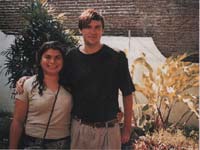
Mike Wood with Elin Weinstein, BA'97, in Yogyakarta, their home base in Indonesia
Photo: Pat Anderson
|
Our friend and guide, Agus, had expressed no surprise about our plan to travel to this remote location. Neither he nor the guidebooks had warned of the hairpin turns, limited visibility, frightening glimpses of the valley below or the mixture of panic and resignation which arises when you are in a perilous situation that you can do nothing about.
Yet I certainly understand why, centuries ago, people were drawn to this spot and went to the unimaginable trouble of building a temple on top of the mountain. There was a spiritual quality to this place, so cut off from the normal rhythms of everyday life. Indeed, Candi Ceto is still believed to be the abode of supernatural powers and remains a place of pilgrimage. Javanese of various religious persuasions and practitioners of local mysticism come here to pray and to meditate, sometimes for days.
A PhD candidate at the McGill Institute of Islamic Studies, I had the good fortune to be in Indonesia from September 1996 until June 1997 on a fellowship funded by the Canadian International Developent Agency. I spent most of my time in Yogyakarta (universally referred to as Yogya and pronounced Jo-JAH), a city which vies for the title of "centre of Javanese culture." Before leaving Canada, I'd read about Indonesia, spoken to Indonesian friends at McGill about their home islands, cities and villages, even watched the film The Year of Living Dangerously, and I thought I was well informed about current political and economic developments. Nevertheless, I wasn't quite prepared for how confusing -- yet exhilarating -- life in a different culture could be.
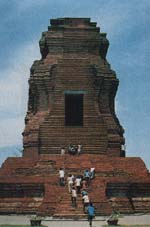
The red brick remains of a 14th century Hindu temple
Photo: Michael Wood
|
Unlike many people, I could locate Indonesia on a map, although like many people I had to be told that Yogyakarta is not a suburb of the Indonesian capital, Jakarta, but is in fact eight hours away by train. The tropical Southeast Asian archipelago of Indonesia is a land of superlatives. Composed of 14,000 islands, it has the world's largest Muslim population, estimated at 170 million. In fact, while Indonesia guarantees freedom of religion, it doesn't offer freedom from religion; it is illegal to be an atheist. Indonesia is the world's fourth most densely populated country (with 200 million inhabitants), features the world's hottest cuisine (Sumatra's padang cooking), was the site of the world's loudest explosion (the volcano of Krakatoa exploded off the coast of Sumatra in 1883, a bang heard as far away as Burma and Australia) and may be the largest single nation of which most Canadians are profoundly ignorant.
Although people have immigrated to Canada from all over the world, bringing their customs, languages, music and food, very few Indonesians have settled in Canada. Visiting students may be the largest enclave and they're expatriates, doing in Canada what I was planning to do in Indonesia, and that included going home. Few Canadians have been exposed to the melodious tones of the Indonesian language, sampled rendang (Sumatran spiced beef cooked in coconut milk) or heard the ethereal sounds of gamelan music. Indonesia's ancient monuments, the Buddhist and Hindu temples of Borobodhur and Pram-banan, do not fire the popular imagination in the same way as the Taj Mahal or the pyramids.
Nation building and shared history
I had come to Indonesia for several reasons. First, I wanted to learn the national language, bahasa ludonesia, a beautiful tongue which has much in common with Malay. In fact, except for the preponderance of Dutch words in the former and English words in the latter, they are basically the same language whose differences reflect separate colonial histories. Indonesians proudly tell you that theirs is the easiest language in the world to learn. It uses neither tenses nor genders; plurals are simply a matter of repeating a word twice. Thus, the plural of kucing (cat) is kucing-kucing. The alphabet is Latin, so I could read signs right away, and in a very short time I found that I could carry on simple conversations.
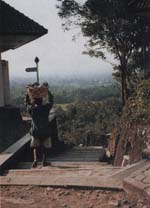
A view of the lush countryside surrounding the Solo River in central Java
Photo: Pat Anderson
|
Second, I had a specific research project to conduct, which dealt with how "the past" is used today for nation-building purposes. Most, if not all, countries use perceptions of history for political purposes. In newly inde-
pendent or developing countries, where governments and cultural elites may command only tenuous loyalty from citizens, history is often used to create shared perceptions of what it means to be a citizen and to impress on the citizenry that they have a shared past, a unified present and a hopeful future.
Using the past in this manner is especially important in countries where there is a wide diversity of languages and cultures, since citizens of a multi-ethnic nation may not share much of a history at all, beyond the common experience of European colonialism and the struggle for independence. In Indonesia, around 140 million people speak Javanese, while some of the languages of Irian Jaya, in the country's far eastern regions, have only a few thousand speakers. Altogether, there are several hundred languages spoken in Indonesia. While the majority of Indonesians are Muslim, there are also sizable numbers of Hindus (concentrated in the island of Bali), Christians (especially in the eastern islands), as well as numerous followers of indigenous religious systems.
I was in Indonesia to examine the process of how a government creates a shared history. Part of my research consisted of interviewing historians, archaeologists and professors from several universities about their training, their funding and their areas of interest.
I read about official government policy towards the past and towards tourism, an industry that often involves "selling" the past to attract foreign capital. I was interested in what historical events the Indonesian government chose to raise monuments to and what objects were chosen for display in museums. I visited secular and religious shrines, museums and monuments in Java and Bali, such as the pilgrimage sites around Surabaya connected with the wali songo, the semi-legendary saints who are said to have brought Islam to Java, the picture-perfect "sea temples" of Bali and the "nationalistic theme park," Taman Mini Indonesia Indah, several hundred acres of displays celebrating Indonesia, built by Madame Tien Suharto outside Jakarta after a trip to Disneyland.
I sought out information on what vision of the past is presented to Indonesian students and what textbooks they read. I was particularly interested in whether the past presented to the Indonesian nation had a temporal or ideological emphasis. Were particular time periods identified as part of an Indonesian "golden age"? Are there alternative "official histories" popular with groups, such as those seeking a more Islamic destiny for Indonesia, outside the political mainstream?
Life in a kampung
While studying the culture and history of the country, I was also learning about everyday life in a kampung, an Indonesian neighbourhood. Traditionally, Indonesian kampungs were walled affairs often housing extended families whose members practised the same trade. Examples of such walled quarters can still be found in the vicinity of the palace of the Sultan of Yogyakarta and are home to the families of his hereditary servants. But for good or ill, Indonesia has recently undergone a great deal of modernization and some Indonesian neighbourhoods, with driveways and front lawns, can hardly be described as traditional kampungs. Ours fell somewhere in between the ultra-modern suburb and the intimate lamplit world of narrow winding streets which had filled my over-romanticized view of what life would be like in the ancient Javanese city of Yogyakarta. Along with fellow McGill graduate Elin Weinstein, BA'97, I lived for much of the time in a kampung on the edge of town in an area of low houses bordering on rice paddies. Livestock (cows, goats and, before religious festivals, lambs) were kept nearby and wandering chickens were a constant traffic hazard. Local residents were not poor, but certainly could not be considered middle class, although there were some impressively large houses nearby.
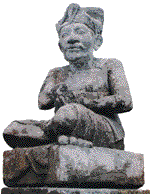
This figure stands guard at the steps of one of Bali's thousnds of temples
Photo: Michael Wood
|
Our neighbours seemed to be more observant Muslims than the residents of other areas of town, since many local women wore the jilbab head scarf and there were four or five mosques within earshot -- one in fact was next door. During the 1997 general election the area was conspicuous in its support for the PPP, the more Muslim-oriented of Indonesia's legal political parties.
Bathing facilities in our small, four-room house were traditional, consisting of twin mandis, basins which one would fill with cold water and then pour over oneself with a cup or dipper. This method of showering was very refreshing after a day-long confrontation with the traffic of Yogya but was not a very pleasant experience in the chill of the early morning. Cooking facilities were similarly basic. A simple propane range was more than adequate to cook our naive attempts at Indonesian curries. But eating out was usually cheaper, either at a roadside stall, or warung, which served Indonesian dishes and "backpacker fare," including the ubiquitous banana pancakes for breakfast or, when we were really culturally disoriented, the local KFC or McDonald's. We would also get takeout from Bungo Palo, an amazing eating establishment at the end of our street offering spicy rendang wrapped in banana leaves for easy transport.
If our house was not equipped with all the latest conveniences it was both spacious and bright, with its own courtyard and even a large television. Thus, we not only got our fix of subtitled X-Files, Star Trek: The Next Generation and Beverly Hills 90210, but we also got to catch President Suharto's latest pronouncements and came to understand the class and regional distinctions of local programming. For example, the more dramatic Indonesian soap operas tended to be set in Jakarta among the emerging middle class -- a world of Japanese cars, shopping malls and nightclubs -- while the more comedic local offerings tended to focus on life in a traditional rural kampung and on the misdeeds of the village gossip. But who needs television when you have cicak? These small, extremely appealing lizards scurry about the walls of many an Indo-nesian household, providing free entertainment (their name comes from the delicate hissing noise they make) while keeping the mosquitoes at bay.
Living in this area was a unique opportunity to get to know Javanese life. I was happy to find that we blended into the neighbourhood. We socialized with our neighbours, which inclu-
ded students and our landlord Sayudi, and with the shop owners across the street, who introduced us to Fanta Hijau or green Fanta -- definitely an acquired taste -- which blends the flavours of bubble gum and mint to create what some considered a truly refreshing soft drink. I was able to converse in Indonesian (to my knowledge no one in the neighbourhood spoke English) and was glad to be able to avoid the jarring gulf between Indonesians and foreigners one so often encounters in Jakarta.
In fact, Indonesians are very open to foreign visitors. Barring one or two minor incidents, I never really had an uncomfortable encounter with the many Indonesians I met and talked to. Confusing, yes, frustrating, sometimes, but I never encountered hostility. Indonesia definitely operates at a different pace; our obsession with schedules, timetables and budgets seems out of place in the heat of the tropics. Indonesians place greater importance on getting to know those who have made the effort to visit their islands (of which they are intensely proud). At the same time, Indonesians possess a remarkable "can-do" attitude. If one wants to go to an obscure archaeological site, there is no need to rent a car -- and deal with the bureaucratic monster. You need only talk to a hotel clerk, or go to a bar or restaurant and state your intentions. Soon enough someone will come up to you and the negotiating will begin for a car and driver. If no one in the immediate area can fulfil your request, someone will be found.
Despite Team Canada trips and an impressive Canadian business presence, as a country we really don't have a high profile among Indonesians. Probably as many of them can locate Canada on a map as vice versa, but the name Canada inevitably produces a positive response, although the cries of "Ben Johnson" have been replaced by "Bre-X," first as a sign of easy wealth and later, as we were leaving, as a symbol of folly.
Culture shock and upheaval
Because I had spent time abroad before on archaeological digs in Central America and the Middle East, I had arrogantly assumed that I was immune from the well-documented disorder of culture shock. I forgot that previously I had been insulated from the particulars of local life by being part of a larger group of travellers, all sharing a common purpose and, more importantly, a common routine. In Indonesia, I found out that there was a great deal of difference between visiting a place, surrounded with the protective identity of a tourist, and living in a place, where you must cope with the frustrations of daily life and such minutiae as how to pay your electrical bill and where to buy a band-aid.
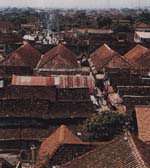
A hilltop view of downtown Yogya
Photo: Pat Anderson
|
Opportunities to learn how other people actually live provide the surprise of discovery but also a yearning for the familiar. By the date of my departure, I was anxious to get home and had begun to plan which of my favourite Montreal restaurants I would hit first. But soon after arriving back in Canada, I really started to miss the place. I talked about Indo-nesia constantly, much to the annoyance of those who had never been there. My academic pursuits began to focus almost exclusively on Southeast Asia and I planned ways to return. I was hooked.
Although it has only been a short time, much has changed in Indonesia since I was there. Canadians were shocked by the violent images from May 1998 of a Jakarta on fire and a government about to collapse. At least 1,000 demonstrators were killed. The rupiah has been drastically devalued from 1,700 to the dollar when I left to 8,000 to the dollar just over a year later. Banks and businesses have closed. Suharto, "the smiling general," is gone amid charges of corruption, greed and nepotism. Indonesia faces new violence and an uncertain political and economic future. Nevertheless, the Indonesia I encountered worked its magic on me and I am anxious to get back. I know that many of the things I was most taken by may no longer be evident; many of the things that disturbed me (like poverty, the inertia of bureaucracy and traffic congestion) may be worse. No matter, I've changed too -- was changed by my experience there. Now I can't wait to rediscover this strange place half a globe away, and I am very curious to see how I will react to this new Indonesia as it deals with the daunting challenges ahead.
|